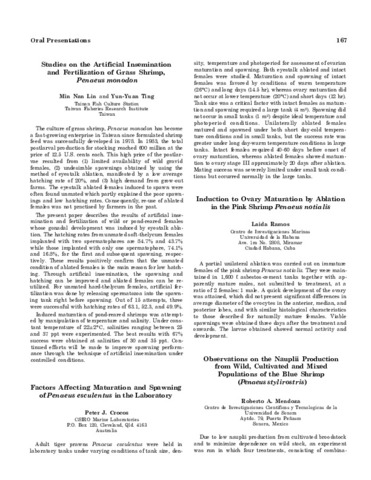Factors affecting maturation and spawning of Penaeus esculentus in the laboratory
- Global styles
- MLA
- Vancouver
- Elsevier - Harvard
- APA
- Help
Share
Abstract
Adult tiger prawns Penaeus esculentus were held in laboratory tanks under varying conditions of tank size, density, temperature and photoperiod for assessment of ovarian maturation and spawning. Both eyestalk ablated and intact females were studied. Maturation and spawning of intact females was favored by conditions of warm temperature (26°C) and long days (14.5 hr), whereas ovary maturation did not occur at lower temperature (20°C) and short days (12 hr). Tank size was a critical factor with intact females as maturation and spawning required a large tank (4 m2). Spawning did not occur in small tanks (1 m2) despite ideal temperature and photoperiod conditions. Unilaterally ablated females matured and spawned under both short day-cold temperature conditions and in small tanks, but the success rate was greater under long day-warm temperature conditions in large tanks. Intact females required 40-60 days before onset of ovary maturation, whereas ablated females showed maturation to ovary stage III approximately 20 days after ablation. Mating success was severely limited under small tank conditions but occurred normally in the large tanks.
Description
Abstract only.
Suggested Citation
Crocos, P. J. (1985). Factors affecting maturation and spawning of Penaeus esculentus in the laboratory (Abstract only). In Taki Y., Primavera J.H. and Llobrera J.A. (Eds.). Proceedings of the First International Conference on the Culture of Penaeid Prawns/Shrimps, 4-7 December 1984, Iloilo City, Philippines (p. 167). Iloilo City, Philippines: Aquaculture Department, Southeast Asian Fisheries Development Center.
Type
Oral presentationISBN
9718511008



